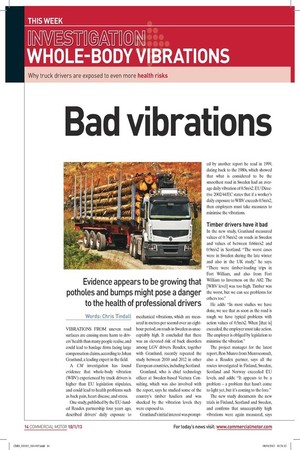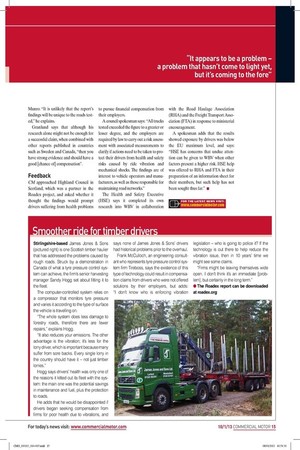ad vibrations Evidence appears to be growing that
Page 10

Page 11

If you've noticed an error in this article please click here to report it so we can fix it.
ad vibrations Evidence appears to be growing that potholes and bumps might pose a danger to the health of professional drivers Words: Chris Tindall VIBRATIONS FROM uneven road surfaces are causing more harm to drivers' health than many people realise, and could lead to haulage firms facing large compensation claims, according to Johan Granlund, a leading expert in the field.
A CM investigation has found evidence that whole-body vibration (WBV) experienced by truck drivers is higher than EU legislation stipulates, and could lead to health problems such as back pain, heart disease, and stress.
One study, published by the EU-funded Roadex partnership four years ago, described drivers' daily exposure to mechanical vibrations, which are measured in metres per second over an eighthour period, on roads in Sweden as unacceptably high. It concluded that there was an elevated risk of back disorders among LGV drivers. Roadex, together with Granlund, recently repeated the study between 2010 and 2012 in other European countries, including Scotland.
Granlund, who is chief technology officer at Sweden-based Vectura Consulting, which was also involved with the report, says he studied some of the country's timber hauliers and was shocked by the vibration levels they were exposed to.
Granlund's initial interest was prompted by another report he read in 1999, dating back to the 1980s, which showed that what is considered to be the smoothest road in Sweden had an average daily vibration of 0.5m/s2. EU Directive 2002/44/EC states that if a worker's daily exposure to WBV exceeds 0.5m/s2, then employers must take measures to minimise the vibrations.
Timber drivers have it bad In the new study, Granlund measured values of 0.76m/s2 on roads in Sweden and values of between 0.66m/s2 and 0.9m/s2 in Scotland. "The worst cases were in Sweden during the late winter and also in the UK study," he says. "There were timber-loading trips in Fort William, and also from Fort William to Inverness on the A82. The [WBV level] was too high. Timber was the worst, but we can see problems for others too."
He adds: "In most studies we have done, we see that as soon as the road is rough we have typical problems with action values of 0.5m/s2. When [that is] exceeded, the employer must take action. The employer is obliged by legislation to minimise the vibration."
The project manager for the latest report, Ron Munro from Munroconsult, also a Roadex partner, says all the routes investigated in Finland, Sweden, Scotland and Norway exceeded EU levels, and adds: "It appears to be a problem — a problem that hasn't come to light yet, but it's coming to the fore."
The new study documents the new trials in Finland, Scotland and Sweden, and confirms that unacceptably high vibrations were again measured, says Munro. "It is unlikely that the report's findings will be unique to the roads tested," he explains.
Granlund says that although his research alone might not be enough for a successful claim, when combined with other reports published in countries such as Sweden and Canada, "then you have strong evidence and should have a good [chance of] compensation".
Feedback CM approached Highland Council in Scotland, which was a partner in the Roadex project, and asked whether it thought the findings would prompt drivers suffering from health problems to pursue financial compensation from their employers.
A council spokesman says: "All trucks tested exceeded the figure to a greater or lesser degree, and the employers are required by law to carry out a risk assessment with associated measurements to clarify if actions need to be taken to protect their drivers from health and safety risks caused by ride vibration and mechanical shocks. The findings are of interest to vehicle operators and manufacturers, as well as those responsible for maintaining road networks."
The Health and Safety Executive (HSE) says it completed its own research into WBV in collaboration with the Road Haulage Association (RHA) and the Freight Transport Association (FTA) in response to ministerial encouragement.
A spokesman adds that the results showed exposure by drivers was below the EU maximum level, and says: "HSE has concerns that undue atten- tion can be given to WBV when other factors present a higher risk. HSE help was offered to RHA and FTA in their preparation of an information sheet for their members, but such help has not been sought thus far." •









































